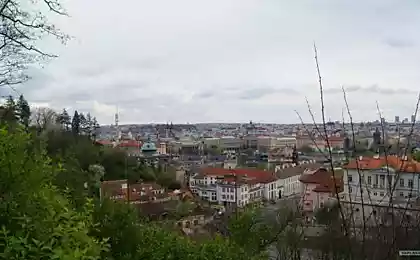827
A trip to Kexholm (60foto, + letters)
60 pictures (all numbered)!
Finally, by early spring, I was honored to "finish" a report about the trip to the Karelian Isthmus in the middle of autumn. To begin with,:
= 01
Remember the old joke network:
xxx: I will not smoked cheese in pigtails fly!
yyy: Why?
xxx: As soon as I buy it there and then he told me of the bag begins to speak: "Buy a beer, buy beer!»
yyy: You talk with cheese ?! O_o
So, to find out where did this come from vkusnyuschy cheese "Korela" decided last warm September day trip to the city Kexholm (Kexholm - «Kukushkin Island"), now Priozersk. That there is a fortress on the name of the settlement of local people "Korel».

= 02
The necessary historical information.
Text from Wikipedia ©:
Evidence of the exact time base of Karelian settlement on the river Uzerve (Vuoksa) has not survived, but the result of numerous excavations can conclude the existence of Karelian settlement on the site of the fortress Korela in the XII century. According to the annals and chronicles it is known that in 1295 a fortified point in the mouth Vuoksa squad plundered Swedish knights in Swedish chronicle of the item called Kexholm and Russian - Korel. Perhaps this settlement was one of the commercial and political center Korela tribe. In the same year Novgorod repulsed him, and in 1310 built a Uzerve-Vuoksa capital fortress, destroying the old.
The fortified town, which has become a powerful outpost of Novgorod on the Karelian Isthmus, deter aggression Swedes.
Through Korela held "alternate" route of the water trade route "from the Vikings to the Greeks." Through Vuoksa could get into the Gulf of Finland and central Finland. Sweden sought to establish control over this strategically important route from the end of the XIII century Korela subjected to repeated attacks by the Swedes.
By the end of the XV century Korela was the administrative center of the northern part (Korelskaya half) Vodskaya fifths Novgorod land later - Korelskogo County. As part of the county more than 300 settlements.
According to 1568 the city had 406 yards townspeople, yards governor, lord (head of the church district), the boyars and nobles. There were four monasteries and one church.
In the fall of 1580 Korela was taken by Swedish troops. All Korelskiy county was under Swedish rule until 1595, when he was returned to Russia on Tyavzinskomu agreement.
From August 1610 to February 1611 Korella withstood the siege of Swedish troops under the command of Jacob De la Gardie, but after a prisoner in 1617 Stolbovo, Korela with the district was ceded to Sweden. From 1634, the city - the capital of the county as part of Kexholmsky Sweden.
September 8, 1710 during the Great Northern War Kexholmsky fortress (the Swedish name Korely) was taken by the Russian troops. In honor of the capture of the fortress was knocked Kexholmsky commemorative medal. Kexholm is now served as a military outpost on the outskirts of the Russian capital - St. Petersburg. City Kexholm Kexholmsky became the center of the province, while in 1743 she was included in the newly formed province of Vyborg, divided into counties, including Kexholm. Since the XVIII century, the fortress changed the purpose and began to serve as a prison. In the middle of the XIX century the city's population was reduced from 1743 persons in 1840 to 1181 person in 1873 then, in the middle of the XIX century, the city began to emerge the first industrial enterprises.
December 31, 1917 The Council of People's Commissars chaired by Lenin made a decision on Finland's independence. As a result of the Tartu Peace Treaty in 1920, along with other city parishes of the Karelian Isthmus, is a part of the Vyborg province, came from Russia. After the Soviet-Finnish war of 1939-1940 as a result of the peace treaty on March 12, 1940 the city was transferred to the Soviet Union.
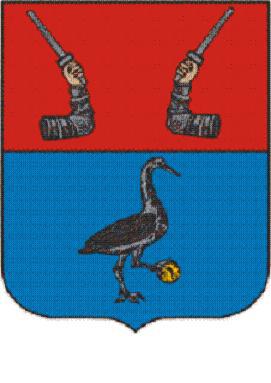
= 03
Sitting in the train did not waste time, and decided to shoot from the window of lakes of Karelia. Here one frame, the rest - a bonus:

= 04
Arriving in the glorious city of Priozersk and leaving the station square I immediately wondered: where to buy all sorts of goodies that was not boring for a walk? Behind the thick bushes, I saw the inviting letters "sa ..." and rushed there. What was my disappointment when I saw the empty and dusty windows closed, it seems forever, shabby door. Even the sign of the tin with a long-lost letter was illuminated greetings from Russian «Silent Hill»: «FOOD MAG ZIN»:

= 05
By the way, like "Hello from the USSR" is not uncommon in this 715-year-old city:

= 06
In the middle of the square stands a monument to the station Beeline. In fact, the other face of the cube busy clock dial.
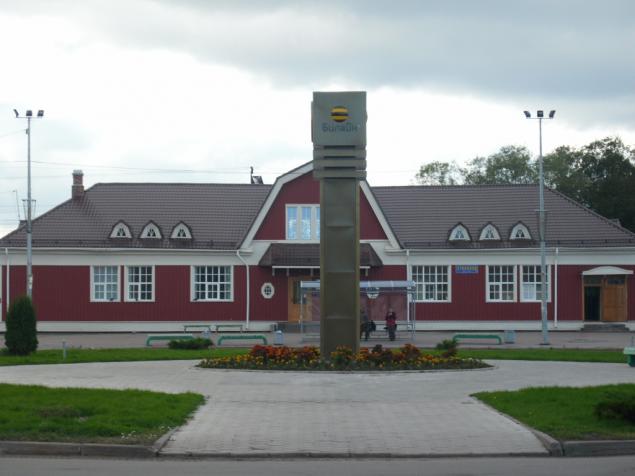
= 07
In every city has its "avenue", where shops and cinemas. In Priozersk are parallel to one another streets of Lenin and Kalinin between wherewith a distance of about 30 meters and greenery with a few houses - a sort of "Boulevard" on kotoryi is local "cinema and concert hall", district police station and post office, telegraph office (all in buildings style "rannestalinskogo constructivism"). Address of the communication:

= 08
Immediately after the post visible to the central market square (exactly between the streets of Lenin and Kalinin!), One end of which stands the Cathedral of the Nativity of the Virgin (1847).

= 09
According to the modern interior decoration of this temple has been spared the fate of the subsequent looting and vegetating as a warehouse.
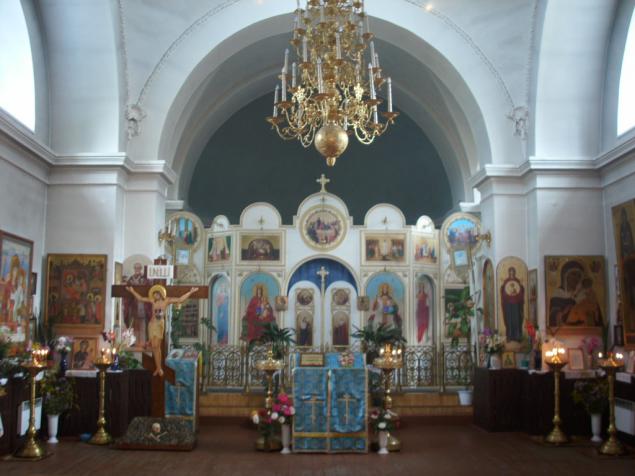
= 10
View of the Cathedral from the Market Square.
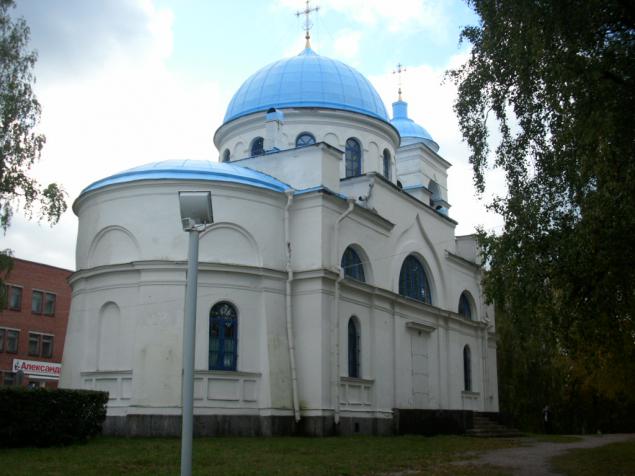
= 11
Very creatively decided to supply lighting of the cathedral. I can see the picture as a rainy evening, sir, pray, God willing sticks bravely bared wire into the three-phase outlet on a birch.
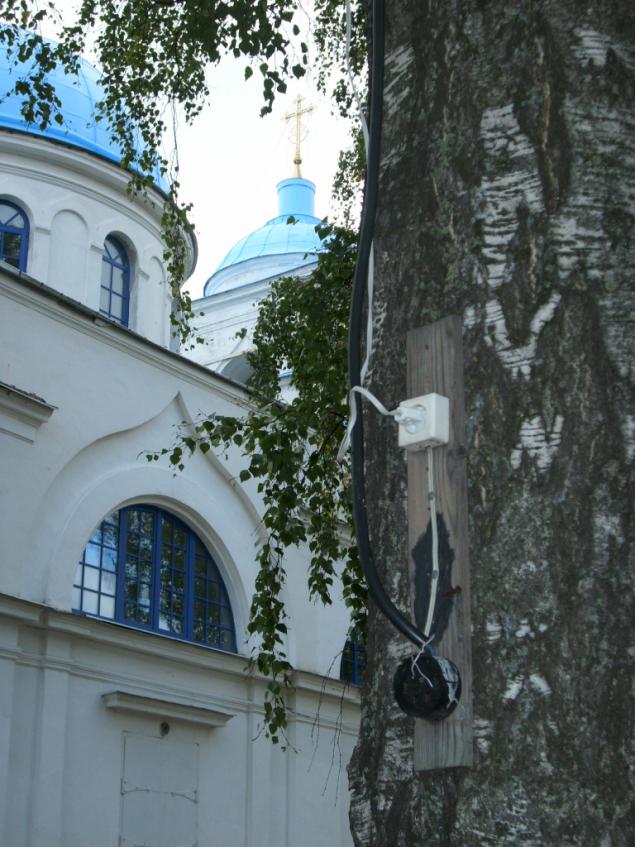
= 12
From the walls of the temple on the square watching the bust to Peter I, it seems, replica, donated to the city by foreigners. On the pedestal with all the "old regime" "yatyami" and "eryami" memorable lyrics written by Peter the First from some alien Regiment.
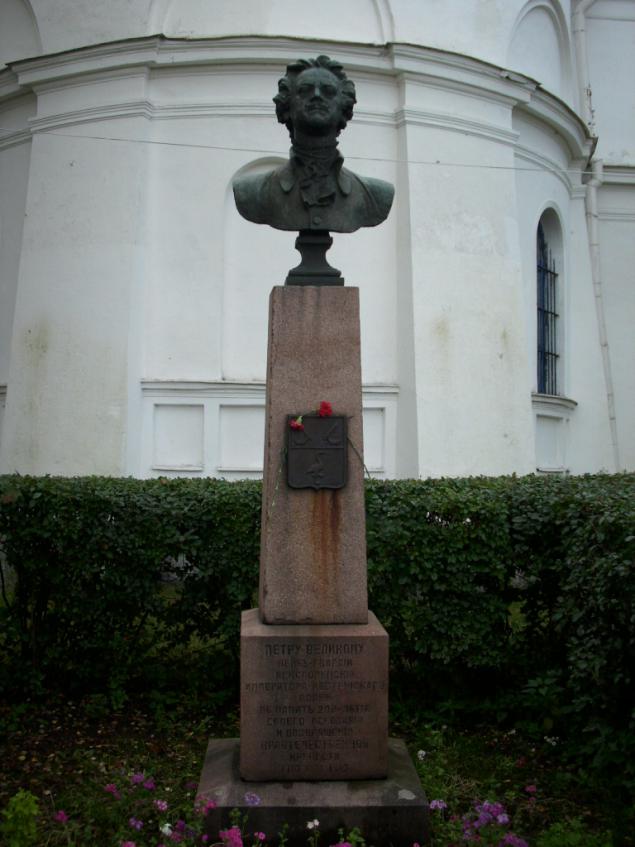
= 13
A very curious appearance, called "eyes" Peter: Mobile chained carousel, which apparently just been supplied by "blessing" outlet. On the other side of the square on the composition Peter Temple-carousel admires Lenin inevitable.

= 14
Here he is handsome, "Lenin silver!"
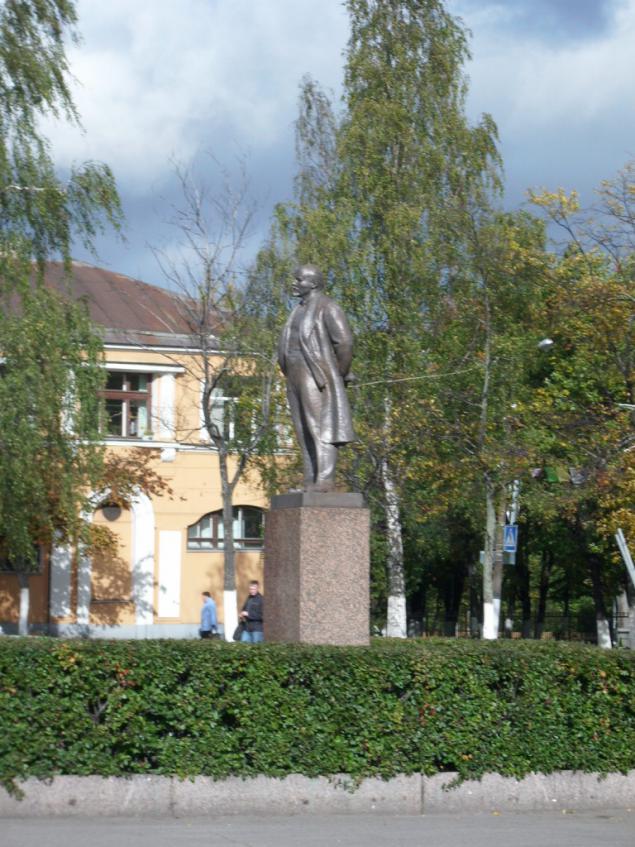
= 15
Behind Lenin, among the trees, hiding the world's only monument to Mowgli Bagheera. Moreover, "sketched" they soyuzmultfilmovskih characters. However, Bagheera looks pretty shabby and miserable, and Mowgli - as a Goth, leprosy.

= 16
Going a little further down the street Kalinin see another local attraction ONLY (!) In Priozersk intersection with traffic lights! It is not surprising: on the streets is difficult to see a car traveling at the same time the two, and it is a crossroads Chervonoarmiiska street that runs through Priozersk highway A129. But I think that traffic lights comrades surprise, so just turn off on Krasnoarmeyskaya and after 200 meters to the right we see a true miracle: the entrance to the resort LnenVoenOkruga among firs perched true "silver" Ilyich!

= 17
"Grandpa Lenin crushes the lice and fleas in his underwear»:

= 18
LVO Sanatorium is on the lake and the river Vuoksi, and across the river - a memorial in honor of the 55th anniversary of the Victory.

= 19
In the foreground of the tank IS-3.

= 20
And it is - self-propelled artillery ISU-152
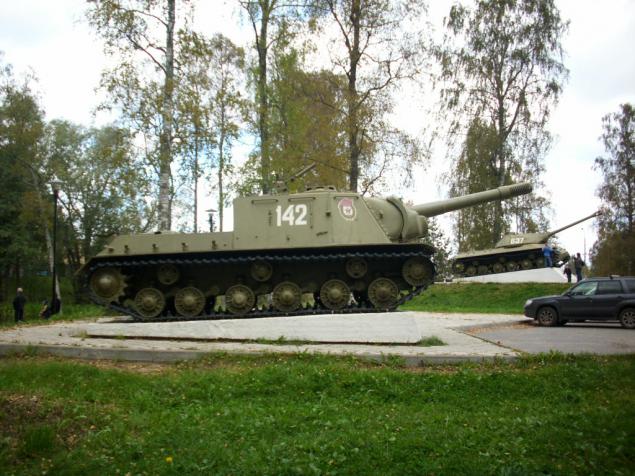
= 21
But for a memorial, and the main purpose of travel:
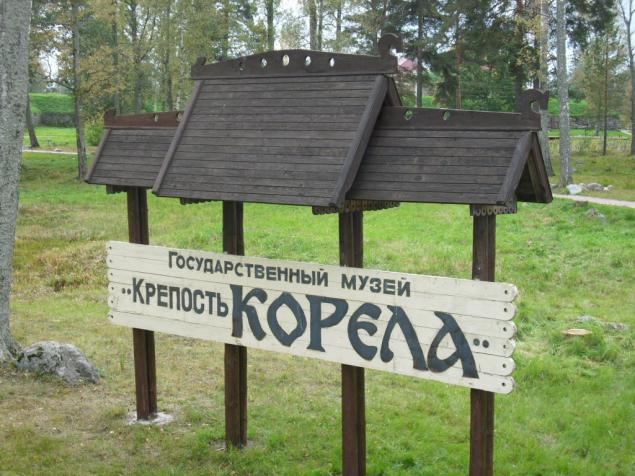
= 22
Between ramparts entrance to the fortress "Korela", designated columns with signs in both languages.

= 23
This path leads from the gate fortifications (tenaille) to the gate of the fortress.
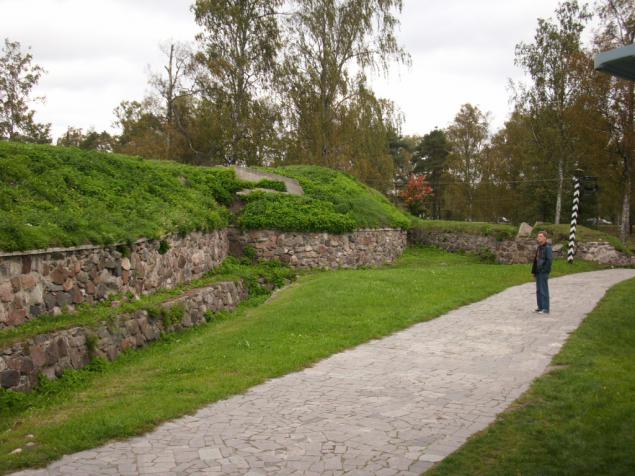
= 24
These forged Vorotina - entrance to the castle Korela - and this is the name of the entrance Water (Mill) gates.

= 25
The length of the tunnel shows what the thickness of the walls of the fortress.
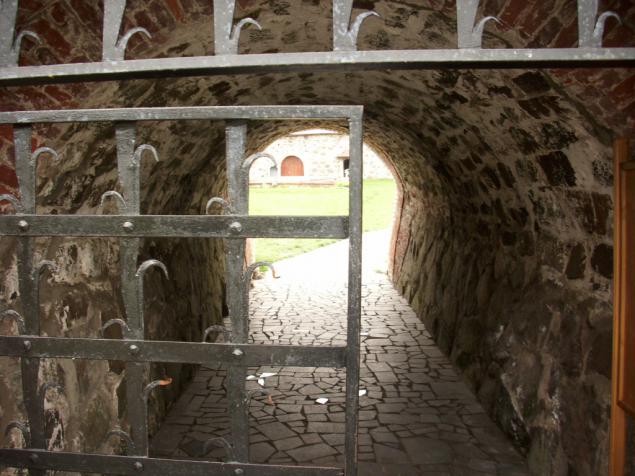
= 26
The first thing that can be seen from the entrance - a New Arsenal, the porch is decorated with cannon.

= 27
General view of the new "Suvorov" Arsenal (1770.) And the Old Arsenal (Artillery house).

= 28
Old Arsenal and Cavalier bastion (tower Pipe). Everything has been restored and re-built in the early 1590s.

= 29
On this board, located on the wall Pipe tower, said that the fortress Korela monument and protected by the state. (tee-hee)
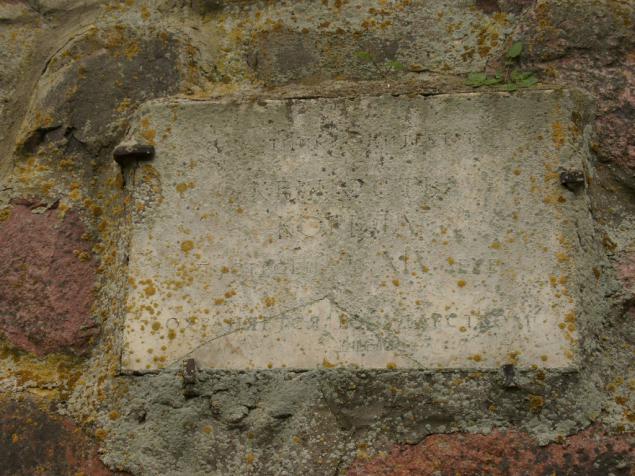
= 30
View along the walls and towers of the Pipe / powder keg at a round gate tower Lars Torstensson (Pugachёvskaya Tower)

= 31
Old Arsenal and the Round Tower.

= 32
As any tourist facility here, too, are found, "mummers" for fotkany.

= 33
"Mummers" 2
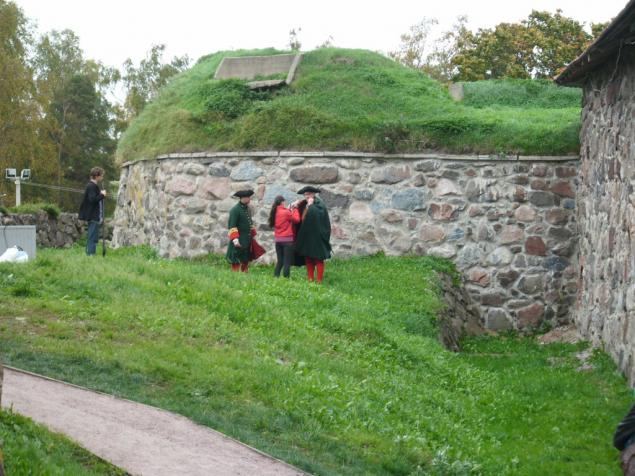
= 34
Runs, vrazhina!

= 35
Old and New Arsenal Arsenal from the other side.

= 36
Local "custodian": jowly black cat.

= 37
Inside the fortress examined all - went back.
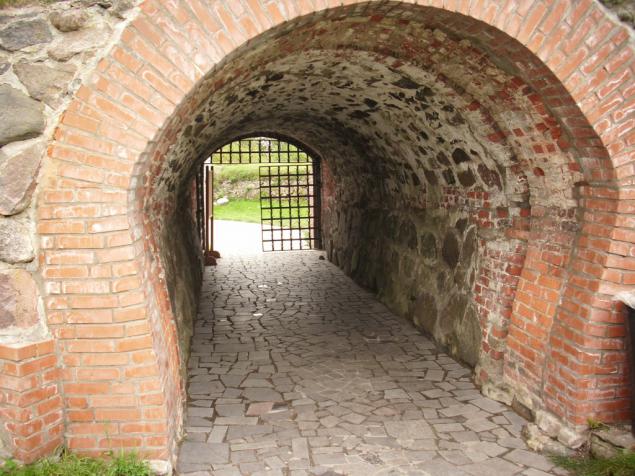
= 38
Just look inside interesting, but it is impossible to leave the medieval walls without examining them outside.
During the inspection team I saw welcoming "guest workers" who had to rebuild part of the fortress wall crumbles. We went despite the barrage signs, and narrow-eyed workers did not break away from the absorption portion of an instant noodle, but simply nodded Baska on the question: "Is it possible to shoot?".

= 39
Around the fortress wall there zareshёchennye passages that are not available for penetration, but perhaps they are in the tunnels inside the walls.

= 40
Appearance of the other gates - water (the Mill). Their idea is simple: before the gates of a small patch of land on the edge of the lake Vuoksi, not giving the possibility to install a device or attacking battering mortar without the prejudice of the defense. Strait is the gate in front of so narrow that any enemy ship is achievable for the fortress guns.
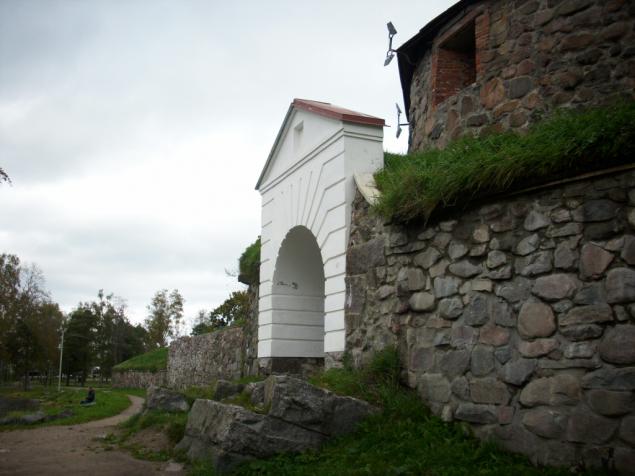
= 41
... The striped gate.

= 42
General view of the Round Tower Lars Torstensson portal with a water gate and tubular tower.

= 43
Stone, established in 2004 next to the fortress on the banks of the Vuoksi and fountain directly from the lake.
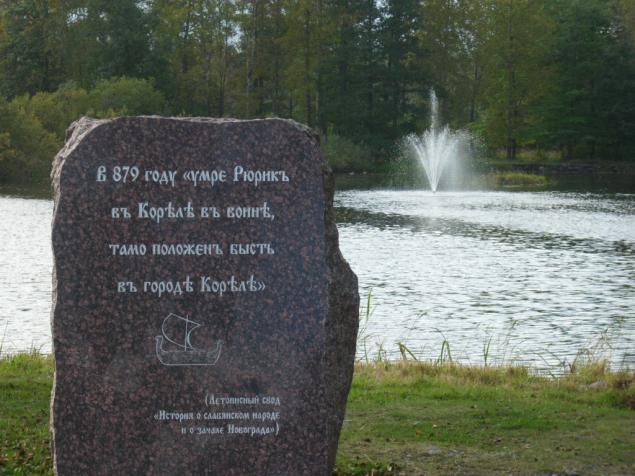
= 44
We leave the castle and go look for another monumental project: New Evangelical Lutheran Church, built by the Finns in 1930.

= 45
What a mass!

= 46
On the side of the church is seen some memorial
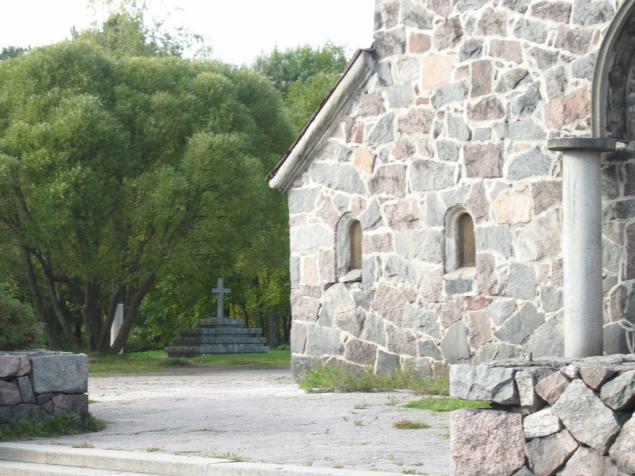
= 47
Based on the architecture, the memorial rather "Novodel."

= 48
And indeed put Finns in the late 90s.

= 49
The windows of an abandoned church were sewn gray iron roofing sheets with painted bindings of window frames. Chance of iron torn and broken glasses in the draft fluttering gray duster, window curtain.

= 50
It turns out that the former church is not completely abandoned, and left the porch of a modern brick extension to the current input.

= 51
It turned out that there is located (attention!) "Center for the prevention of deviant behavior"! Ie for all sorts of "asocial" individuals with "disabilities". Of harm's way we have decided not to go inside.
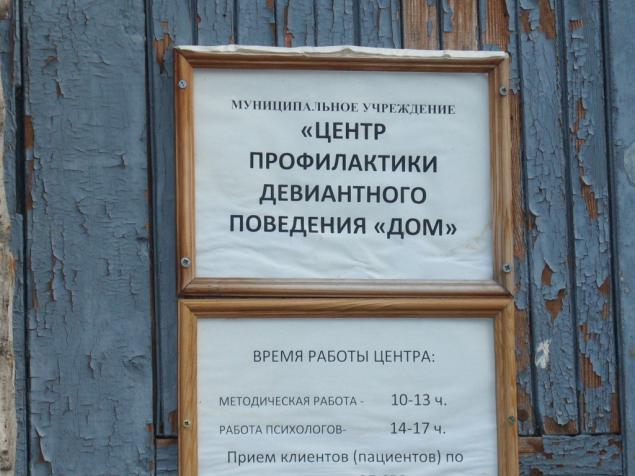
= 52
Close to an extension on a concrete slab example of creativity "deviants" with the reassuring slogan "Russian pig - the best in the world!" And kosoryloy pig with a glass of riding on the acorn. It seems that the "good citizens" had pririsovat pig dick with tits and bombard it from the "pneumatic".

= 53
Next direct your feet to the Church of All Saints in 1892, located in the Old Believers' cemetery.

= 54
Temple, to our regret, has been in "woods", but it pleased: it restores and do not allow to die.
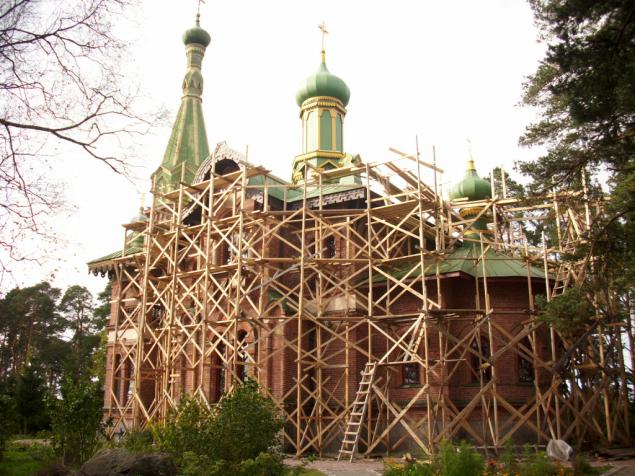
= 55
On the way back through the "private sector", where all the streets are named after Russian writers could not pricked combination of "patriarchal" shabby architecture with signs of modernity of the XXI century.
Gorky Street:

= 56
"Devil" house Pushkin Street:

= 57
On the way toward the station went to the local shop and bought a pig breeding plant is still Karelian product: gentle and fragrant fat, which then in the train safely "halve" Priozersk with some bread.
The last noteworthy, seen in this ancient town was a small wooden house standing among prefabricated high-rise buildings.

= 58
This modest house turned out to be a chapel in the name of Reverend Arseny Konevsky, who lived in Russia in the XIV century. Small chapel built in 1999.

= 59
Waiting for the train had the pleasure to enjoy the lake Vuoksa directly to the train platform.

= 60
The view from the train window (sail - like romantishno!)

= 61
That's all!

Source:
Finally, by early spring, I was honored to "finish" a report about the trip to the Karelian Isthmus in the middle of autumn. To begin with,:
= 01
Remember the old joke network:
xxx: I will not smoked cheese in pigtails fly!
yyy: Why?
xxx: As soon as I buy it there and then he told me of the bag begins to speak: "Buy a beer, buy beer!»
yyy: You talk with cheese ?! O_o
So, to find out where did this come from vkusnyuschy cheese "Korela" decided last warm September day trip to the city Kexholm (Kexholm - «Kukushkin Island"), now Priozersk. That there is a fortress on the name of the settlement of local people "Korel».

= 02
The necessary historical information.
Text from Wikipedia ©:
Evidence of the exact time base of Karelian settlement on the river Uzerve (Vuoksa) has not survived, but the result of numerous excavations can conclude the existence of Karelian settlement on the site of the fortress Korela in the XII century. According to the annals and chronicles it is known that in 1295 a fortified point in the mouth Vuoksa squad plundered Swedish knights in Swedish chronicle of the item called Kexholm and Russian - Korel. Perhaps this settlement was one of the commercial and political center Korela tribe. In the same year Novgorod repulsed him, and in 1310 built a Uzerve-Vuoksa capital fortress, destroying the old.
The fortified town, which has become a powerful outpost of Novgorod on the Karelian Isthmus, deter aggression Swedes.
Through Korela held "alternate" route of the water trade route "from the Vikings to the Greeks." Through Vuoksa could get into the Gulf of Finland and central Finland. Sweden sought to establish control over this strategically important route from the end of the XIII century Korela subjected to repeated attacks by the Swedes.
By the end of the XV century Korela was the administrative center of the northern part (Korelskaya half) Vodskaya fifths Novgorod land later - Korelskogo County. As part of the county more than 300 settlements.
According to 1568 the city had 406 yards townspeople, yards governor, lord (head of the church district), the boyars and nobles. There were four monasteries and one church.
In the fall of 1580 Korela was taken by Swedish troops. All Korelskiy county was under Swedish rule until 1595, when he was returned to Russia on Tyavzinskomu agreement.
From August 1610 to February 1611 Korella withstood the siege of Swedish troops under the command of Jacob De la Gardie, but after a prisoner in 1617 Stolbovo, Korela with the district was ceded to Sweden. From 1634, the city - the capital of the county as part of Kexholmsky Sweden.
September 8, 1710 during the Great Northern War Kexholmsky fortress (the Swedish name Korely) was taken by the Russian troops. In honor of the capture of the fortress was knocked Kexholmsky commemorative medal. Kexholm is now served as a military outpost on the outskirts of the Russian capital - St. Petersburg. City Kexholm Kexholmsky became the center of the province, while in 1743 she was included in the newly formed province of Vyborg, divided into counties, including Kexholm. Since the XVIII century, the fortress changed the purpose and began to serve as a prison. In the middle of the XIX century the city's population was reduced from 1743 persons in 1840 to 1181 person in 1873 then, in the middle of the XIX century, the city began to emerge the first industrial enterprises.
December 31, 1917 The Council of People's Commissars chaired by Lenin made a decision on Finland's independence. As a result of the Tartu Peace Treaty in 1920, along with other city parishes of the Karelian Isthmus, is a part of the Vyborg province, came from Russia. After the Soviet-Finnish war of 1939-1940 as a result of the peace treaty on March 12, 1940 the city was transferred to the Soviet Union.

= 03
Sitting in the train did not waste time, and decided to shoot from the window of lakes of Karelia. Here one frame, the rest - a bonus:

= 04
Arriving in the glorious city of Priozersk and leaving the station square I immediately wondered: where to buy all sorts of goodies that was not boring for a walk? Behind the thick bushes, I saw the inviting letters "sa ..." and rushed there. What was my disappointment when I saw the empty and dusty windows closed, it seems forever, shabby door. Even the sign of the tin with a long-lost letter was illuminated greetings from Russian «Silent Hill»: «FOOD MAG ZIN»:

= 05
By the way, like "Hello from the USSR" is not uncommon in this 715-year-old city:

= 06
In the middle of the square stands a monument to the station Beeline. In fact, the other face of the cube busy clock dial.

= 07
In every city has its "avenue", where shops and cinemas. In Priozersk are parallel to one another streets of Lenin and Kalinin between wherewith a distance of about 30 meters and greenery with a few houses - a sort of "Boulevard" on kotoryi is local "cinema and concert hall", district police station and post office, telegraph office (all in buildings style "rannestalinskogo constructivism"). Address of the communication:

= 08
Immediately after the post visible to the central market square (exactly between the streets of Lenin and Kalinin!), One end of which stands the Cathedral of the Nativity of the Virgin (1847).

= 09
According to the modern interior decoration of this temple has been spared the fate of the subsequent looting and vegetating as a warehouse.

= 10
View of the Cathedral from the Market Square.

= 11
Very creatively decided to supply lighting of the cathedral. I can see the picture as a rainy evening, sir, pray, God willing sticks bravely bared wire into the three-phase outlet on a birch.

= 12
From the walls of the temple on the square watching the bust to Peter I, it seems, replica, donated to the city by foreigners. On the pedestal with all the "old regime" "yatyami" and "eryami" memorable lyrics written by Peter the First from some alien Regiment.

= 13
A very curious appearance, called "eyes" Peter: Mobile chained carousel, which apparently just been supplied by "blessing" outlet. On the other side of the square on the composition Peter Temple-carousel admires Lenin inevitable.

= 14
Here he is handsome, "Lenin silver!"

= 15
Behind Lenin, among the trees, hiding the world's only monument to Mowgli Bagheera. Moreover, "sketched" they soyuzmultfilmovskih characters. However, Bagheera looks pretty shabby and miserable, and Mowgli - as a Goth, leprosy.

= 16
Going a little further down the street Kalinin see another local attraction ONLY (!) In Priozersk intersection with traffic lights! It is not surprising: on the streets is difficult to see a car traveling at the same time the two, and it is a crossroads Chervonoarmiiska street that runs through Priozersk highway A129. But I think that traffic lights comrades surprise, so just turn off on Krasnoarmeyskaya and after 200 meters to the right we see a true miracle: the entrance to the resort LnenVoenOkruga among firs perched true "silver" Ilyich!

= 17
"Grandpa Lenin crushes the lice and fleas in his underwear»:

= 18
LVO Sanatorium is on the lake and the river Vuoksi, and across the river - a memorial in honor of the 55th anniversary of the Victory.

= 19
In the foreground of the tank IS-3.

= 20
And it is - self-propelled artillery ISU-152

= 21
But for a memorial, and the main purpose of travel:

= 22
Between ramparts entrance to the fortress "Korela", designated columns with signs in both languages.

= 23
This path leads from the gate fortifications (tenaille) to the gate of the fortress.

= 24
These forged Vorotina - entrance to the castle Korela - and this is the name of the entrance Water (Mill) gates.

= 25
The length of the tunnel shows what the thickness of the walls of the fortress.

= 26
The first thing that can be seen from the entrance - a New Arsenal, the porch is decorated with cannon.

= 27
General view of the new "Suvorov" Arsenal (1770.) And the Old Arsenal (Artillery house).

= 28
Old Arsenal and Cavalier bastion (tower Pipe). Everything has been restored and re-built in the early 1590s.

= 29
On this board, located on the wall Pipe tower, said that the fortress Korela monument and protected by the state. (tee-hee)

= 30
View along the walls and towers of the Pipe / powder keg at a round gate tower Lars Torstensson (Pugachёvskaya Tower)

= 31
Old Arsenal and the Round Tower.

= 32
As any tourist facility here, too, are found, "mummers" for fotkany.

= 33
"Mummers" 2

= 34
Runs, vrazhina!

= 35
Old and New Arsenal Arsenal from the other side.

= 36
Local "custodian": jowly black cat.

= 37
Inside the fortress examined all - went back.

= 38
Just look inside interesting, but it is impossible to leave the medieval walls without examining them outside.
During the inspection team I saw welcoming "guest workers" who had to rebuild part of the fortress wall crumbles. We went despite the barrage signs, and narrow-eyed workers did not break away from the absorption portion of an instant noodle, but simply nodded Baska on the question: "Is it possible to shoot?".

= 39
Around the fortress wall there zareshёchennye passages that are not available for penetration, but perhaps they are in the tunnels inside the walls.

= 40
Appearance of the other gates - water (the Mill). Their idea is simple: before the gates of a small patch of land on the edge of the lake Vuoksi, not giving the possibility to install a device or attacking battering mortar without the prejudice of the defense. Strait is the gate in front of so narrow that any enemy ship is achievable for the fortress guns.

= 41
... The striped gate.

= 42
General view of the Round Tower Lars Torstensson portal with a water gate and tubular tower.

= 43
Stone, established in 2004 next to the fortress on the banks of the Vuoksi and fountain directly from the lake.

= 44
We leave the castle and go look for another monumental project: New Evangelical Lutheran Church, built by the Finns in 1930.

= 45
What a mass!

= 46
On the side of the church is seen some memorial

= 47
Based on the architecture, the memorial rather "Novodel."

= 48
And indeed put Finns in the late 90s.

= 49
The windows of an abandoned church were sewn gray iron roofing sheets with painted bindings of window frames. Chance of iron torn and broken glasses in the draft fluttering gray duster, window curtain.

= 50
It turns out that the former church is not completely abandoned, and left the porch of a modern brick extension to the current input.

= 51
It turned out that there is located (attention!) "Center for the prevention of deviant behavior"! Ie for all sorts of "asocial" individuals with "disabilities". Of harm's way we have decided not to go inside.

= 52
Close to an extension on a concrete slab example of creativity "deviants" with the reassuring slogan "Russian pig - the best in the world!" And kosoryloy pig with a glass of riding on the acorn. It seems that the "good citizens" had pririsovat pig dick with tits and bombard it from the "pneumatic".

= 53
Next direct your feet to the Church of All Saints in 1892, located in the Old Believers' cemetery.

= 54
Temple, to our regret, has been in "woods", but it pleased: it restores and do not allow to die.

= 55
On the way back through the "private sector", where all the streets are named after Russian writers could not pricked combination of "patriarchal" shabby architecture with signs of modernity of the XXI century.
Gorky Street:

= 56
"Devil" house Pushkin Street:

= 57
On the way toward the station went to the local shop and bought a pig breeding plant is still Karelian product: gentle and fragrant fat, which then in the train safely "halve" Priozersk with some bread.
The last noteworthy, seen in this ancient town was a small wooden house standing among prefabricated high-rise buildings.

= 58
This modest house turned out to be a chapel in the name of Reverend Arseny Konevsky, who lived in Russia in the XIV century. Small chapel built in 1999.

= 59
Waiting for the train had the pleasure to enjoy the lake Vuoksa directly to the train platform.

= 60
The view from the train window (sail - like romantishno!)

= 61
That's all!

Source:









